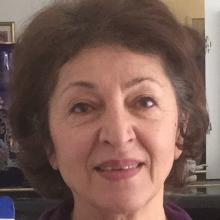Meet the Expert: Jaleh Soroui

Jaleh Soroui leads the AIR team that provides expertise, technical assistance, and management for the U.S. Department of Education’s National Center for Education Statistics (NCES). Throughout her career, Jaleh has been at the forefront of incorporating education technology into adult education. She is passionate about effective communication and dissemination of research, so that community stakeholders and policymakers understand the challenges around adult education and can use data to inform policy.
Position: Director, Program for the International Assessment of Adult Competencies (PIAAC) at AIR
Areas of Expertise: Adult education, information sciences, large-scale assessments
Years of Experience: 35+
Q: You’ve been with PIAAC since its inception in 2012. What is the study intended to examine, and how has it evolved over time?
Jaleh: PIAAC was designed to measure and compare the basic literacy, numeracy, and digital problem-solving skills of adults in participating countries. This study came about to address policymakers’ desire to know how these skills affect education, occupation, employment, health, and civic participation outcomes; how these skills are distributed across demographics, regions, industries, and other variables; and what factors contribute to skill acquisition and decline.
PIAAC has gained much broader recognition among U.S. researchers and practitioners since we started. In the first few years of the project, when we attended conferences, most people hadn’t heard of PIAAC. Now, most people have. AIR and the PIAAC team—with major support from NCES—conducted massive outreach efforts, including presentations at over 140 conferences since late 2013, personal outreach to individual researchers, and executing three of our own Research-to-Practice conferences.
Q: How can data collected by PIAAC be used in the field?
Jaleh: Dissemination and outreach comprise a large part of our responsibilities with PIAAC. This is extremely important to me personally—we’re not collecting data for its own sake; we want it to be useful and to help people make informed decisions.
In some ways, PIAAC data provides a snapshot of the skills of the U.S. adult population: It tells us where our education and training systems stand, and what we need in order to meet the demands of 21st century, highly competitive societies and economies. That’s why our team and NCES have spent so much energy making sure researchers and policymakers know about—and understand—PIAAC data.
For instance, PIAAC data show that there are 43 million U.S. adults with low literacy, 63 million U.S. adults with low numeracy skills, and millions more with no or very low digital literacy skills. In my opinion, this data could and should inform education policy in this country. Also, last April, NCES released state and county estimates, which provide data about the literacy and numeracy skills of adults in all 50 U.S. states and all 3,141 U.S. counties. These data are an incredible resource and tool to help state and local program policymakers understand their constituents and set priorities and plans accordingly.
Q: What are some common misconceptions around adult education?
Jaleh: There’s a big misconception that only certain groups, such as immigrants and minorities, need additional education and training. As it turns out, the majority of low-skilled adults in the United States were born in this country. Furthermore, when breaking down the results by race or ethnicity, white adults form one of the largest demographics of low-skilled individuals.
PIAAC data show that there are 43 million U.S. adults with low literacy, 63 million U.S. adults with low numeracy skills, and millions more with no or very low digital literacy skills. In my opinion, this data could and should inform education policy in this country.
Another misconception is that education equals skills. PIAAC data show a strong correlation between education and literacy skills, but there is no degree or number of years of schooling that automatically confers literacy, numeracy, or digital problem-solving skills. Within the low-skilled group, there are adults with high levels of education. This demonstrates that across the board—including those who have completed their educations and may be employed—there are still opportunities for additional, nonformal education and training that could help build and maintain skills.
Relatedly, there is a misconception that low-skilled adults are not employed; in fact, over two-thirds of low-skilled adults are employed. That’s why private sector employer involvement is a crucial piece of adult education; this can benefit individuals, organizations, and society as a whole. In fact, the benefits of upskilling are multigenerational: PIAAC showed that the education level of parents affects the skills of children throughout their adult lives.
Q: PIAAC conducts research both nationally and internationally. How is adult education in the United States the same—or different—from other countries?
Jaleh: In November 2019, NCES released results that compared the skills of adults, ages 16 to 65, in 32 different participating countries, including the United States. Overall, U.S. adults scored higher in literacy than the international average, but lower in numeracy and digital problem-solving. The United States is notably below top-performing countries, such as Japan and Finland.
The need for additional education and training around numeracy is particularly noteworthy. Only 39 percent of U.S. adults performed at higher levels, compared to 63 percent in Japan and 58 percent in Finland. Conversely, over 28 percent of U.S. adults performed at the lowest levels, compared to 8 percent in Japan and 13 percent in Finland. The skills of young adults in the U.S. are also lower than those of their peers in other countries, which should alert us of the need for investing in upskilling today’s young adults, who will become majority of the future U.S. workforce.
Q: Your work at PIAAC combines your expertise in both educational technology and adult literacy. Which skill set came first for you?
Jaleh: I would say those two skill sets developed simultaneously and have consistently fed into each other. I studied information sciences in the early 1980s, when the use of digital technology at a large scale was still very new. When I became the director of a county-wide adult literacy program in California, I tried to integrate technology into the project; I wanted to use it to help the low-skilled adult participants we served.
Then, in 1993, I was hired by the U.S. Department of Education to establish the Literacy Information and Communication System (LINCS) to bring technology into the adult education and adult literacy field. (LINCS was actually among the first 100 websites in the country—it still exists today and remains an excellent resource.) In recent years, of course, technology has become a necessity and has transformed nearly every aspect of our lives. Technology can make a big difference in people’s skills levels and professional competencies, so I’ve always tried to include it in my adult education work.
Q: Where can we find you on a typical Saturday afternoon?
Jaleh: I’m usually in my backyard, planting new herbs and flowers, or getting rid of weeds!
Q: What book would you suggest everyone read?
Jaleh: “The Code Breaker: Jennifer Doudna, Gene Editing, and the Future of the Human Race,” by Walter Isaacson. It’s about Nobel Prize winner Jennifer Doudna and her colleagues, who developed CRISPR, a tool that can edit DNA, cure diseases, and eliminate viruses. It’s fascinating!
